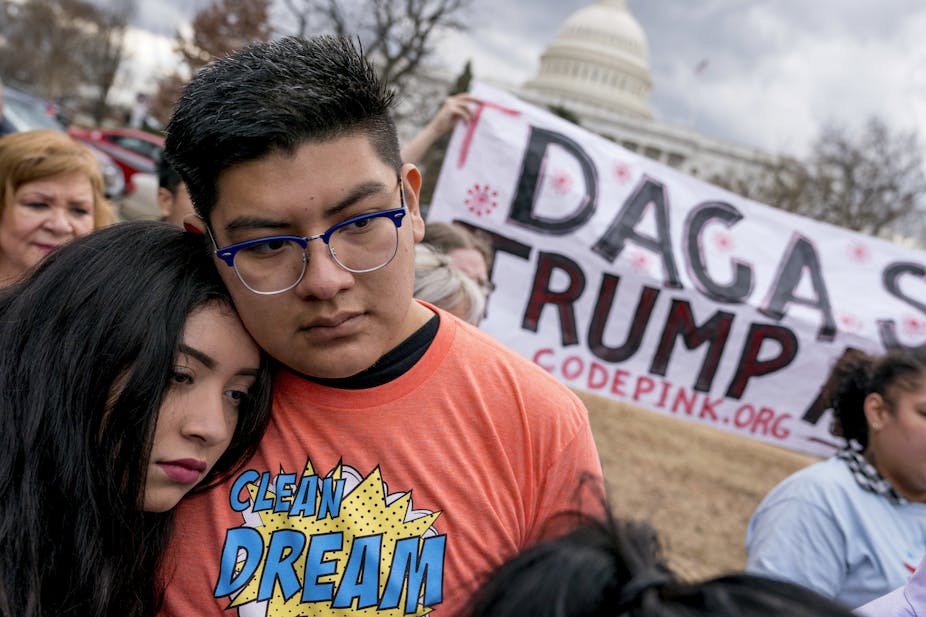The final day for an Obama-era program called Deferred Action for Childhood Arrivals, or DACA, was set to be March 5.
In 2017, President Donald Trump and Attorney General Jeff Sessions announced they would shut down the program.
However, immigrants and the University of California filed separate lawsuits against Trump’s attempt to end it. Two federal courts ruled to reinstate the program until the cases are resolved in court.
In the meantime, Congress also failed to agree on a durable solution, despite a week-long debate on the issue.
Thus, the future remains uncertain for young people who were brought to the U.S. as children without legal authorization. Here is a roundup of archival stories to help you understand DACA and the Dreamers’ dilemma.
1. DACA’s terms and conditions
DACA came with a long list of terms and conditions. For example, to apply you had to be a certain age and meet certain educational requirements.
Immigration scholar Kevin Johnson of the University of California, Davis, points out, DACA offered protection for only about 1.8 million of the estimated 3.6 million people who were brought to the U.S. as children. Of those 1.8 million who were eligible, only about 800,000 actually applied and received protection through DACA.
2. DACA doesn’t cover unaccompanied minors
It’s important to point out that DACA also does not apply to “unaccompanied minors.” You may have heard the term used especially in 2014, when unprecedented numbers of children traveling alone were arriving at the U.S. border with Mexico. Generally, these case are handled under a different set of laws and policies.
Stephanie Canizales, a Ph.D. candidate at the University of Southern California, Dornsife, has spent time doing in-depth interviews and observational research on this group of migrants, who face a separate set of issues around labor exploitation.
Canizales writes, “Undocumented working youth migrate to Los Angeles in hopes of working to support their families who remain in their home countries. … Much like with their adult coworkers, economic necessity and fear of removal from the workplace and the country keep undocumented migrant youth workers quiet in cases of exploitation, and docile and efficient on the job.”
3. DACA improves mental health
There is research that shows that DACA has improved the mental health of those who received it. Scholars Elizabeth Aranda of the University of South Florida, and Elizabeth Vaquera of George Washington University, explain that being an undocumented immigrant in the U.S. carries with it severe mental health consequences. These include problems such as chronic worry, sadness, isolation and even suicidal thoughts.
Although DACA only offers temporary protection, the relief recipients felt was significant. They write, “These youth shared with us that they were more motivated and happy after Obama’s executive order. As Kate, one of our participants, told us, DACA ‘has gone a long way to give me some sense of security and stability that I haven’t had in a very long time.’”
4. Dreamers would boost US economy
DACA critics have suggested that undocumented immigrants negatively impact the U.S. economy because they steal jobs from native-born people. In fact, there is growing evidence that shows how incorporating undocumented immigrants into the workforce actually boosts economic growth. For example, take City University of New York sociologist Amy Hsin’s study that shows what would happen if the DREAM Act was passed.
She found that it would have no significant effect on the wages of U.S.-born workers. It would create more economic opportunities by encouraging legalized immigrants to make education gains. Hsin writes, “Overall, we estimate that the increases in productivity under the DREAM Act would raise the United States GDP by US$15.2 billion and significantly increase tax revenue.”
5. The moral argument for Dreamers
Arguably, at the core of the effort to protect Dreamers is a belief that the U.S. has a tradition of embracing those who arrive at its shores seeking a better life. However, a quick scan of history would reveal that the U.S. has not in fact always been so welcoming. As Carrie Tirado Bramen of the University at Buffalo explains, many writers have described U.S. history as an “ongoing duel between generosity and greed.”
Bramen writes that this issue gets at the core of American identity: “At stake is not only the fate of the Dreamers, but also how the country and the rest of the world understands the idea of America.”
6. Millions still in the shadows
Dreamers are the main impetus for the current debate on immigration. As professor Matthew Wright of American University points out, a victory for Dreamers would be seen as a big “win” for Democrats and some Republicans.
Meanwhile, Trump and immigration hard-liners see it as an opportunity to strike a deal that would also include funding for additional security at the U.S.-Mexico border.
Neither side has sought to address the remaining millions of undocumented immigrants who are not Dreamers, and who have created lives and community ties in the U.S. For decades, Congress has stalled on comprehensive immigration reform that would offer undocumented immigrants a path to legal status. Even if Congress passes a Dreamer solution, the vast majority of undocumented immigrants will continue to live in fear of detention, deportation and long-term family separation.
This is an updated version of an article originally published on February 14, 2018.

